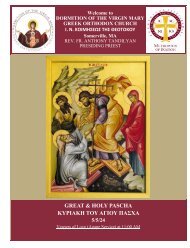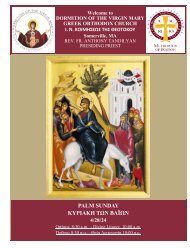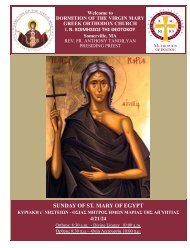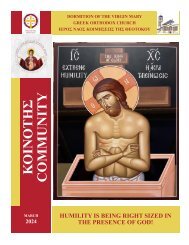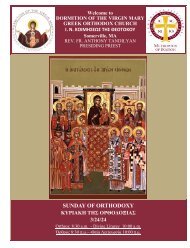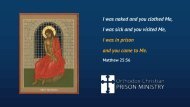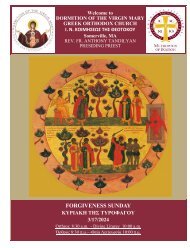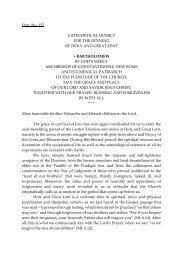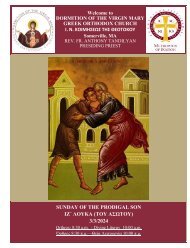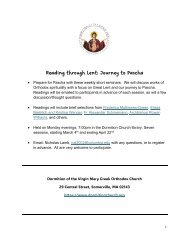You also want an ePaper? Increase the reach of your titles
YUMPU automatically turns print PDFs into web optimized ePapers that Google loves.
Dormithion <strong>Greek</strong> <strong>Orthodox</strong> <strong>Church</strong><br />
29 Central St. Somerville MA<br />
. Tel: (617) 625-2222<br />
Web: http://www.dormitionchurch.org/<br />
. E-mail:franthony@dormithionchurch.org<br />
March 1, 2019<br />
Dear <strong>Altar</strong> Server <strong>candidate</strong>s,<br />
I want to emphasize to you just how important it is <strong>for</strong><br />
you to serve in <strong>the</strong> Divine Liturgy. You will be helping make<br />
<strong>the</strong> Liturgy run smoothly, reverently, and beautifully, as it<br />
should be. This is why it is very important to have <strong>Altar</strong> <strong>Boy</strong>s<br />
present at <strong>the</strong> Divine Liturgy. I invite you to come and serve<br />
anytime you want including <strong>the</strong> weekday Liturgies if your<br />
school schedule permits.<br />
If you are interested in becoming an altar boy,<br />
please contact me by<br />
E-mail at franthony@<strong>Dormition</strong>church.org<br />
or by<br />
phone at (617) 625 2222.<br />
Your decision to serve is very important, and we are<br />
here to help you in any way we can to make it possible. For<br />
that reason, we will be <strong>of</strong>fering <strong>Altar</strong> <strong>Boy</strong> preparation<br />
seminars every month <strong>for</strong> younger students and <strong>for</strong><br />
newcomers.<br />
1
Please spread <strong>the</strong> word to your friends if you know any<br />
one who may be interested in serving in <strong>the</strong> altar, and I will<br />
add <strong>the</strong>ir names to <strong>the</strong> list <strong>of</strong> our new <strong>Altar</strong> <strong>Boy</strong>s.<br />
One last thing, be<strong>for</strong>e you make your decision to join<br />
o<strong>the</strong>rs in serving on <strong>the</strong> <strong>Altar</strong>:<br />
Please remember that <strong>the</strong> Liturgy is <strong>the</strong> continuation<br />
<strong>of</strong> <strong>the</strong> LAST SUPPER with our Lord and Savior Jesus Christ<br />
and although He is in Heaven at <strong>the</strong> Right Hand <strong>of</strong> The<br />
Fa<strong>the</strong>r, He is also always present with us here at <strong>the</strong><br />
Liturgy.<br />
There<strong>for</strong>e, ga<strong>the</strong>ring around <strong>the</strong> <strong>Altar</strong> Table with <strong>the</strong><br />
Lord, is a great honor <strong>for</strong> each and every one <strong>of</strong> us. We must<br />
be ready and present ourselves in a way that honors God.<br />
Please remember that everything is very important from <strong>the</strong><br />
way we are dressed to our prayerful participation in <strong>the</strong><br />
Divine Liturgy. For this reason, you will find in <strong>the</strong> following<br />
pages some basic expectations <strong>of</strong> what behavior is<br />
anticipated from you as an <strong>Altar</strong> <strong>Boy</strong>.<br />
I’m looking <strong>for</strong>ward to hearing from and meeting you as we<br />
serve toge<strong>the</strong>r in <strong>the</strong> Holy <strong>Altar</strong>.<br />
Love in Christ,<br />
Fr. Anthony Tandilyan<br />
2
So, you’re an altar boy?<br />
I. INTRODUCTION<br />
Perhaps you’ve just decided to become an altar boy may be<br />
you have been an altar boy <strong>for</strong> only a short time, or perhaps <strong>for</strong><br />
many years. You may know quite a bit about being an altar boy, or<br />
you may not. You may have lots <strong>of</strong> questions that you never got<br />
around to asking, or you may not. Whatever <strong>the</strong> case, this book<br />
has been prepared with you in mind.<br />
The <strong>Dormition</strong> <strong>Church</strong> <strong>Altar</strong> <strong>Boy</strong>’s Guidebook will not<br />
answer all your questions—it’s not meant to. Nor is it meant to<br />
teach you <strong>the</strong> best and only way to do things as an altar boy. The<br />
St. Vasilios <strong>Altar</strong> <strong>Boy</strong>’s Guidebook will tell you some <strong>of</strong> <strong>the</strong> ways<br />
<strong>of</strong> doing things. It will help answer some <strong>of</strong> your questions. It is<br />
not so much a <strong>manual</strong>, as it is a workbook, a guidebook. The<br />
<strong>Dormition</strong> <strong>Church</strong> <strong>Altar</strong> <strong>Boy</strong>’s Guidebook is a tool to help you<br />
learn.<br />
3
II. WHAT IS AN ALTAR BOY?<br />
Did you ever wonder why you’re called an “altar boy”? Let’s<br />
see if we can find out.<br />
During <strong>the</strong> early years <strong>of</strong> <strong>the</strong> <strong>Church</strong>, <strong>the</strong> Disciples <strong>of</strong> Christ<br />
found that <strong>the</strong>y were not spending enough time doing <strong>the</strong> job<br />
Christ chose <strong>the</strong>m to do. They were so busy tending to <strong>the</strong> needs<br />
<strong>of</strong> <strong>the</strong> early Christians that <strong>the</strong>y didn’t always have enough time to<br />
go out and tell o<strong>the</strong>r people about Christ and <strong>the</strong> wonderful things<br />
He came to <strong>of</strong>fer us. So <strong>the</strong>y decided to choose some <strong>of</strong> <strong>the</strong> people<br />
to help <strong>the</strong>m. They chose several able men and ordained <strong>the</strong>m to<br />
be deacons. These deacons helped <strong>the</strong> disciples so that <strong>the</strong><br />
disciples could have more time to preach <strong>the</strong> good news <strong>of</strong><br />
salvation to o<strong>the</strong>rs.<br />
As <strong>the</strong> years went by, it was also found that it would be<br />
extremely helpful to have some additional people (besides <strong>the</strong><br />
deacons) helping during <strong>the</strong> various services, especially during <strong>the</strong><br />
Divine Liturgy. There were so many things that had to be done<br />
and prepared. And so, special people were chosen to do just that.<br />
They were called “acolytes.” The word “acolyte” is defined by <strong>the</strong><br />
dictionary as an altar attendant, coming from <strong>the</strong> <strong>Greek</strong> work<br />
“akolouthos,” meaning attendant or follower. In a very real sense,<br />
acolytes were <strong>the</strong> attendants to <strong>the</strong> bishops and priests. They<br />
helped <strong>the</strong>m during <strong>the</strong> various services, much as you, as an altar<br />
boy, help <strong>the</strong> priest today. The word “acolyte” can also be traced<br />
to <strong>the</strong> <strong>Greek</strong> word “akolytos,” meaning free (from stain or sin) to<br />
enter <strong>the</strong> Holy <strong>of</strong> Holies. It is proper and fitting <strong>for</strong> one to serve<br />
<strong>the</strong> Lord in <strong>the</strong> Holy <strong>of</strong> Holies to be “akolytos”—free from stain.<br />
As you know, <strong>the</strong> Divine Liturgy is a dramatic reenactment<br />
<strong>of</strong> <strong>the</strong> life <strong>of</strong> Christ. The priest takes on <strong>the</strong> role <strong>of</strong> Christ. The<br />
altar boys, who are <strong>the</strong> priest’s attendants, are really Christ’s<br />
attendants. We know that <strong>the</strong> attendants <strong>of</strong> Christ are <strong>the</strong> angels.<br />
So you, as an altar boy, are symbolically an angel. As an “angel”<br />
4
you can help minister to Jesus in <strong>the</strong> reenactment <strong>of</strong> <strong>the</strong> life <strong>of</strong><br />
Christ during <strong>the</strong> Divine Liturgy.<br />
The altar, which is more properly called <strong>the</strong> Holy <strong>of</strong> Holies,<br />
is <strong>the</strong> most sacred area <strong>of</strong> <strong>the</strong> church. That is where <strong>the</strong> bread and<br />
wine are <strong>of</strong>fered to God as a sacrifice—a bloodless sacrifice. And<br />
God, accepting our sacrifice, sends down <strong>the</strong> Holy Spirit to change<br />
<strong>the</strong> bread and <strong>the</strong> wine in a miraculous way into <strong>the</strong> Body and<br />
Blood <strong>of</strong> Christ. Only bishops, priests, and deacons are allowed in<br />
<strong>the</strong> altar. Because altar boys are specially chosen and tonsured as<br />
“readers,” <strong>the</strong>y too are allowed into <strong>the</strong> altar. No one else, whe<strong>the</strong>r<br />
a man or a woman, boy or girl, is permitted to go into <strong>the</strong> altar.<br />
When an altar boy is tonsured by <strong>the</strong> bishop as a reader, he<br />
becomes a member <strong>of</strong> <strong>the</strong> order <strong>of</strong> <strong>the</strong> clergy. To become a priest,<br />
a man first must be tonsured a reader, <strong>the</strong>n a sub-deacon, and <strong>the</strong>n<br />
ordained a deacon and <strong>the</strong>n a priest. So a reader is really <strong>the</strong> first<br />
step in <strong>the</strong> holy Priesthood.<br />
To be an altar boy is a special honor. Be<strong>for</strong>e <strong>the</strong> bishop<br />
tonsures altar boys as readers (and only a bishop can do this), <strong>the</strong>y<br />
go through a “trial period” to make sure that <strong>the</strong>y are qualified and<br />
deserve to be altar boys. Not everyone deserves this great honor.<br />
What made you want to become an altar boy?<br />
Did you know that God chose you to become an altar boy and<br />
serve Him? Maybe one day you thought to yourself that you’d like<br />
to become an altar boy. Maybe your parents suggested that you<br />
become an altar boy. Maybe your friends who are altar boys<br />
suggested it—whatever it was, it really was God who called you.<br />
You see, God works through you and through o<strong>the</strong>r people. In His<br />
own way, He called you to serve Him. You should be very happy<br />
that <strong>the</strong> Lord God chose you. He loves you very much. He wants<br />
you to love Him more and more each day. He has given you a<br />
great honor by choosing you to be one <strong>of</strong> His altar boys.<br />
5
III. PREPARATION AT HOME<br />
When it’s your turn to serve in <strong>the</strong> altar, do you do anything<br />
different at home to get ready to go to church? If not, you really<br />
should. Remember, <strong>the</strong> altar is a holy place. You will be touching<br />
things that are holy. When you’re invited to a special party, you<br />
probably spend a lot <strong>of</strong> time getting ready—making sure everything is<br />
just right. Well, you should also make sure everything is just right<br />
when you go to church, and even more so when you know you will be<br />
serving in <strong>the</strong> altar.<br />
Here are some things to watch <strong>for</strong> and ask yourself:<br />
• Is your hair combed?<br />
• Is your hair too long—when was <strong>the</strong> last time you had a haircut?<br />
• Have you taken your bath or shower?<br />
• Did you wash your hands with plenty <strong>of</strong> soap and water just<br />
be<strong>for</strong>e you left your home? Remember, you will be touching and<br />
holding things that are holy.<br />
• What about your pants? Are <strong>the</strong>y ironed and clean? (They should<br />
preferably be dark in color.)<br />
• What about your shoes (preferably black)—are <strong>the</strong>y shined?<br />
• Remember that tennis shoes, sneakers, jeans, unbuttoned<br />
shirts, and o<strong>the</strong>r similar clo<strong>the</strong>s are not proper <strong>for</strong> serving in<br />
<strong>the</strong> altar.<br />
Look in <strong>the</strong> mirror just be<strong>for</strong>e leaving home to make sure everything is<br />
just right.<br />
In short, you, as an altar boy, should be generally clean and<br />
presentable from <strong>the</strong> inside out.<br />
Because you are an altar boy, you should not only be especially<br />
careful when preparing to go to church, but also during <strong>the</strong> rest <strong>of</strong> <strong>the</strong><br />
week as well. You symbolize an angel, and you should <strong>the</strong>re<strong>for</strong>e be<br />
careful how you dress, how you act, how you speak, at all times.<br />
Remember, God has chosen you to serve Him in His holy altar. He<br />
wants to be proud <strong>of</strong> you not just in <strong>the</strong> altar, but all <strong>the</strong> time.<br />
6
IV. BEHAVIOR IN THE ALTAR<br />
As an altar boy you must be careful about your behavior in<br />
<strong>the</strong> altar. Remember—<strong>the</strong> altar is <strong>the</strong> holiest area <strong>of</strong> <strong>the</strong> church.<br />
Here are some things to keep in mind:<br />
THINGS THAT ARE NOT PROPER FOR AN ALTAR BOY TO DO<br />
• Chewing gum<br />
• Talking (this should be done only when absolutely necessary<br />
and only <strong>for</strong> giving instructions <strong>for</strong> processions, etc.)<br />
• Laughing, pushing, making faces, smiling, winking, combing<br />
hair, playing with your robe, incense, candles and candle wax<br />
• Leaving your position (unless to prepare <strong>for</strong> a procession or<br />
to carry out your duties)<br />
• Walking in front <strong>of</strong> <strong>the</strong> <strong>Altar</strong> Table<br />
• Walking through <strong>the</strong> Royal Gate<br />
• Walking too fast while going to designated positions in <strong>the</strong><br />
altar or preparing <strong>for</strong> a procession<br />
• Standing with your hands clasped behind your back<br />
• Dripping wax from a candle onto <strong>the</strong> floor<br />
THINGS THAT ARE PROPER FOR AN ALTAR BOY TO DO<br />
• Holding your hands by your side when standing<br />
• Making <strong>the</strong> sign <strong>of</strong> <strong>the</strong> cross whenever going behind <strong>the</strong> <strong>Altar</strong><br />
Table<br />
• Kissing <strong>the</strong> priest’s hand when he blesses your robe and<br />
whenever you hand him anything or take anything from his<br />
hand<br />
• Holding <strong>the</strong> censer by <strong>the</strong> top rings and not by <strong>the</strong> chains<br />
when handing it to <strong>the</strong> priest<br />
• Making <strong>the</strong> sign <strong>of</strong> <strong>the</strong> cross at <strong>the</strong> appropriate times during<br />
7
<strong>the</strong> services (when <strong>the</strong> name <strong>of</strong> <strong>the</strong> <strong>Virgin</strong> <strong>Mary</strong> or <strong>the</strong> Holy<br />
Trinity is mentioned, at each singing <strong>of</strong> <strong>the</strong> “Αγιος ο Θεος,<br />
(Aghios O Theos)” (Holy God), etc.)<br />
• Neatly hanging up your robe following services<br />
• Quietly helping to clean up following services<br />
• Quietly reciting <strong>the</strong> Creed and <strong>the</strong> Lord’s Prayer at <strong>the</strong><br />
appropriate times during <strong>the</strong> Liturgy. <strong>Altar</strong> boys should have<br />
<strong>the</strong> Creed and <strong>the</strong> Lord’s Prayer memorized ei<strong>the</strong>r in <strong>Greek</strong>,<br />
English, or both. See <strong>the</strong> appropriate texts.<br />
8
V. THE ALTAR BOY’S ROBE<br />
The Sticharion - This is similar to <strong>the</strong> deacon’s sticharion. It is a<br />
long robe with wide sleeves and is called “The<br />
robe <strong>of</strong> salvation and <strong>the</strong> garment <strong>of</strong> joy.” It is<br />
symbolic <strong>of</strong> purity and <strong>of</strong> a spotless life.<br />
The Orarion - Similar to <strong>the</strong> deacon’s orarion, it resembles <strong>the</strong><br />
<strong>for</strong>m <strong>of</strong> a cross, over <strong>the</strong> sticharion. It is<br />
symbolic <strong>of</strong> <strong>the</strong> wings <strong>of</strong> angels.<br />
An altar boy is a symbol <strong>of</strong> an angel. Your robe is a symbol <strong>of</strong><br />
purity and wings <strong>of</strong> an angel. Your robe is really a symbol <strong>of</strong> <strong>the</strong><br />
great honor you have from <strong>the</strong> Lord God.<br />
9
VI. PROCESSIONS<br />
You will probably know how to go out in procession during<br />
<strong>the</strong> various entrances and readings <strong>of</strong> <strong>the</strong> Divine Liturgy. While<br />
<strong>the</strong>re are a number <strong>of</strong> different ways processions can be done, we<br />
will look at a few <strong>of</strong> <strong>the</strong>m <strong>for</strong> you to consider.<br />
The Small Entrance – The First Procession<br />
Symbolism - The beginning <strong>of</strong> Christ’s ministry/preaching.<br />
The priest carries <strong>the</strong> Holy Gospel Book, which<br />
contains a record <strong>of</strong> Christ’s ministry and<br />
preaching.<br />
Items to Be Carried - Two candles<br />
Directions - As <strong>the</strong> priest finishes <strong>the</strong> second series <strong>of</strong><br />
petitions and <strong>the</strong> choir (or chanter) is singing “O Monogenis<br />
Yios,” prepare <strong>for</strong> this procession. Then when <strong>the</strong> priest<br />
finishes <strong>the</strong> third series <strong>of</strong> petitions, kisses <strong>the</strong> Gospel Book,<br />
picks it up, and proceeds to walk behind <strong>the</strong> <strong>Altar</strong> Table, <strong>the</strong><br />
North Door is opened, and <strong>the</strong> procession begins to exit <strong>the</strong><br />
<strong>Altar</strong>.<br />
The first two altar boys proceed to <strong>the</strong> middle back <strong>of</strong> <strong>the</strong><br />
Solea and, one at a time, turn, face <strong>the</strong> <strong>Altar</strong> and bow and<br />
<strong>the</strong>n proceed to <strong>the</strong>ir positions. The one on <strong>the</strong> right goes in<br />
front <strong>of</strong> <strong>the</strong> one on <strong>the</strong> left into <strong>the</strong> North Gate. The one on<br />
<strong>the</strong> left takes a step back and goes in back <strong>of</strong> <strong>the</strong> one on <strong>the</strong><br />
right into <strong>the</strong> South Door. Then <strong>the</strong>y return to <strong>the</strong> <strong>Altar</strong><br />
through <strong>the</strong> door on <strong>the</strong> diagram.<br />
10
11
The Gospel Lesson – The Second Procession<br />
Symbolism - The Word <strong>of</strong> God is preached to <strong>the</strong> faithful.<br />
Items to Be Carried - Two candles<br />
Directions - Prepare <strong>for</strong> <strong>the</strong> procession at <strong>the</strong> epistle reading.<br />
When <strong>the</strong> priest says, “Sophia, Orthoi,<br />
akousomen tou Aghiou Evangeliou, eirini pasi,”<br />
<strong>the</strong>n begin <strong>the</strong> procession. The two candles<br />
proceed to <strong>the</strong> middle back <strong>of</strong> <strong>the</strong> Solea, turn to<br />
<strong>the</strong> <strong>Altar</strong>, bow, and take <strong>the</strong>ir positions.<br />
Upon completion <strong>of</strong> <strong>the</strong> Gospel lesson, <strong>the</strong> first<br />
altar boy closest to <strong>the</strong> <strong>Altar</strong> on ei<strong>the</strong>r side <strong>the</strong>n<br />
proceeds to <strong>the</strong> front-middle <strong>of</strong> <strong>the</strong> Solea. There<br />
<strong>the</strong> two altar boys face <strong>the</strong> <strong>Altar</strong> and bow<br />
toge<strong>the</strong>r, <strong>the</strong>n return to <strong>the</strong> <strong>Altar</strong> through <strong>the</strong><br />
door on <strong>the</strong> diagram.<br />
12
13
The Great Entrance – The Third Procession<br />
Symbolism - The entry <strong>of</strong> Christ into Jerusalem on<br />
Palm Sunday<br />
Items to be Carried - Four to six candles, thimiato (censer)<br />
Directions - Upon reentry from <strong>the</strong> Gospel lesson, prepare <strong>for</strong><br />
<strong>the</strong> Great Entrance. While <strong>the</strong> priest is reading <strong>the</strong><br />
prayers in preparation <strong>for</strong> <strong>the</strong> Great Entrance, <strong>the</strong><br />
altar boy taking <strong>the</strong> censer should prepare <strong>the</strong> incense<br />
to be used. Following <strong>the</strong> censing by <strong>the</strong> priest <strong>of</strong> <strong>the</strong><br />
<strong>Altar</strong>, icons, and people, and upon his signal, <strong>the</strong><br />
procession begins. Slowly proceed down <strong>the</strong> side<br />
aisle, <strong>the</strong>n down <strong>the</strong> middle aisle, to <strong>the</strong> middle-back<br />
<strong>of</strong> <strong>the</strong> Solea, turn to <strong>the</strong> <strong>Altar</strong>, bow, and proceed to<br />
<strong>the</strong>ir positions. The altar boy holding <strong>the</strong> thimiato<br />
(censer), while walking backwards and censing <strong>the</strong><br />
priest holding <strong>the</strong> Holy Gifts, precedes <strong>the</strong> priest to<br />
<strong>the</strong> middle-front <strong>of</strong> <strong>the</strong> Solea, pausing <strong>the</strong>re a<br />
moment. Then he precedes <strong>the</strong> priest to <strong>the</strong> middlefront<br />
<strong>of</strong> <strong>the</strong> Solea. Upon <strong>the</strong> priest’s reentry into <strong>the</strong><br />
<strong>Altar</strong>, <strong>the</strong> altar boy, at <strong>the</strong> middle-front <strong>of</strong> <strong>the</strong> Solea,<br />
faces <strong>the</strong> <strong>Altar</strong>, bows, and returns to <strong>the</strong> <strong>Altar</strong><br />
through <strong>the</strong> North door and proceeds to <strong>the</strong> left side<br />
<strong>of</strong> <strong>the</strong> <strong>Altar</strong> Table where he censes <strong>the</strong> “Aera”—<strong>the</strong><br />
covering <strong>the</strong> priest takes <strong>of</strong>f his shoulders. Then he<br />
hands <strong>the</strong> thimiato to <strong>the</strong> priest (and kisses his hand)<br />
and takes it back (kissing his hand again) when he is<br />
finished. The o<strong>the</strong>r altar boys return as <strong>the</strong>y did<br />
following <strong>the</strong> Gospel lesson.<br />
14
15
The Memorial Service – Mnemosino<br />
Symbolism - Prayers are <strong>of</strong>fered by <strong>the</strong> living <strong>for</strong> <strong>the</strong> wellbeing<br />
<strong>of</strong> <strong>the</strong> soul <strong>of</strong> someone<br />
who has died. Their prayers<br />
help <strong>the</strong> soul <strong>of</strong> that person<br />
feel somewhat refreshed.<br />
Items to Be Carried - Two<br />
candles, censer (thimiato)<br />
Directions - The procession exits <strong>the</strong> South Door at <strong>the</strong><br />
priest’s signal. All three <strong>of</strong> <strong>the</strong> altar boys proceed to <strong>the</strong><br />
table on which <strong>the</strong> koliva (boiled wheat) has been<br />
placed. The two candles stand on ei<strong>the</strong>r side, <strong>the</strong><br />
thimiato on <strong>the</strong> right side <strong>of</strong> <strong>the</strong> table.<br />
Following <strong>the</strong> service, <strong>the</strong> altar boys proceed directly<br />
into <strong>the</strong> South Door.<br />
The Blessing <strong>of</strong> <strong>the</strong> Loaves Service – Artoclasia<br />
Symbolism - Prayers are <strong>of</strong>fered <strong>for</strong> <strong>the</strong> health and well<br />
being <strong>of</strong> <strong>the</strong> family requesting<br />
<strong>the</strong> service. The five loaves <strong>of</strong><br />
bread are symbolic <strong>of</strong> <strong>the</strong> five<br />
loaves Christ used to feed <strong>the</strong><br />
5,000 men on <strong>the</strong> Mount <strong>of</strong><br />
Olives.<br />
Items to Be Carried - Two candles, censer (thimiato)<br />
Directions - The table on which <strong>the</strong> five loaves <strong>of</strong> bread are<br />
placed is positioned in <strong>the</strong> middle <strong>of</strong> <strong>the</strong> Solea. Proceed<br />
16
at <strong>the</strong> signal from <strong>the</strong> priest as <strong>for</strong> <strong>the</strong> Small Entrance,<br />
with <strong>the</strong> thimiato, however, taking up a position on <strong>the</strong><br />
right side <strong>of</strong> <strong>the</strong> table, next to <strong>the</strong> priest. At <strong>the</strong><br />
conclusion <strong>of</strong> <strong>the</strong> service, <strong>the</strong> altar boy holding <strong>the</strong><br />
thimiato will proceed to <strong>the</strong> middle-front <strong>of</strong> <strong>the</strong> Solea,<br />
bow, and return by way <strong>of</strong> <strong>the</strong> North Door. The altar<br />
boys holding <strong>the</strong> candles return as <strong>the</strong>y do <strong>for</strong> <strong>the</strong> Small<br />
Entrance.<br />
After <strong>the</strong> priest reenters <strong>the</strong> <strong>Altar</strong>, <strong>the</strong> two altar<br />
boys proceed to <strong>the</strong> middle-front <strong>of</strong> <strong>the</strong> Solea, face <strong>the</strong><br />
<strong>Altar</strong>, bow, and return to <strong>the</strong> <strong>Altar</strong>, going through <strong>the</strong><br />
door as shown on diagram.<br />
Processions Around The <strong>Church</strong><br />
At times, most especially during special Feastdays (as<br />
September 14, <strong>the</strong> first and third<br />
Sundays <strong>of</strong> Lent, Holy Thursday.<br />
Good Friday, etc.) one <strong>of</strong> <strong>the</strong><br />
processions to be held that day<br />
(usually <strong>the</strong> one toward <strong>the</strong> end <strong>of</strong> <strong>the</strong><br />
service) will circle <strong>the</strong> church. Here is<br />
one possible way that this might<br />
happen:<br />
…upon exiting from <strong>the</strong> North Door, <strong>the</strong> procession will<br />
go down <strong>the</strong> side aisle <strong>of</strong> <strong>the</strong> church.<br />
... at <strong>the</strong> back <strong>of</strong> <strong>the</strong> church, <strong>the</strong> procession will turn and<br />
go across <strong>the</strong> back aisle, going past <strong>the</strong> middle aisle, until<br />
reaching <strong>the</strong> side aisle.<br />
... <strong>the</strong> procession will <strong>the</strong>n return to <strong>the</strong> Solea by way <strong>of</strong><br />
<strong>the</strong> side aisle.<br />
... <strong>the</strong> altar boys upon reaching <strong>the</strong> Solea will take up<br />
17
<strong>the</strong>ir positions.<br />
During some <strong>of</strong> <strong>the</strong>se processions, it is customary <strong>for</strong> <strong>the</strong><br />
processions to stop so that <strong>the</strong> priest can <strong>of</strong>fer various<br />
petitions. It is always best to check <strong>for</strong> <strong>the</strong> appropriate<br />
instructions as to where and when to stop.<br />
18
VII. OTHER DUTIES OF AN ALTAR BOY<br />
Aside from participating in processions, <strong>the</strong>re are a number<br />
<strong>of</strong> o<strong>the</strong>r duties that you are expected to per<strong>for</strong>m as an altar boy.<br />
Here are some <strong>of</strong> <strong>the</strong>m:<br />
The Thimiato<br />
The censer (thimiato) should be watched carefully. Make sure<br />
that <strong>the</strong> charcoal does not burn down so low that incense cannot be<br />
placed on it. If it does need a new piece <strong>of</strong> charcoal, carefully light<br />
one and place it quickly inside <strong>the</strong> thimiato.<br />
Incense should be carefully placed on <strong>the</strong> charcoal only when<br />
needed. Incense is very expensive, so be careful how you use it.<br />
Here are some times <strong>the</strong> priest will need <strong>the</strong> thimiato:<br />
... shortly after <strong>the</strong> Gospel lesson during <strong>the</strong> Orthros service<br />
... at <strong>the</strong> conclusion <strong>of</strong> <strong>the</strong> Proskomide service<br />
... at <strong>the</strong> conclusion <strong>of</strong> <strong>the</strong> Small Entrance<br />
... following <strong>the</strong> consecration <strong>of</strong> <strong>the</strong> bread and wine into <strong>the</strong><br />
Body and Blood <strong>of</strong> Christ (right after kneeling)<br />
... immediately after <strong>the</strong> priest <strong>of</strong>fers Holy Communion to <strong>the</strong><br />
people<br />
(Keep in mind that after <strong>the</strong> priest returns <strong>the</strong> censer to<br />
you, you should wait and lead <strong>the</strong> way back to <strong>the</strong> Pro<strong>the</strong>sis<br />
Table <strong>for</strong> him, while slowly and quietly censing.)<br />
Cutting <strong>the</strong> Pros<strong>for</strong>o into Antidoron<br />
Antidoron means “instead <strong>of</strong> <strong>the</strong> gift” and is <strong>the</strong> name given to <strong>the</strong><br />
bread that is specially blessed and distributed at <strong>the</strong> end <strong>of</strong> <strong>the</strong><br />
Divine Liturgy to <strong>the</strong> people who did not receive Holy<br />
19
Communion (“The gift”).<br />
After <strong>the</strong> Great Entrance, begin quietly to cut <strong>the</strong> pros<strong>for</strong>o<br />
(<strong>the</strong> bread) into small cubes. Following <strong>the</strong> consecration <strong>of</strong> <strong>the</strong><br />
gifts (after kneeling), bring in <strong>the</strong> antidoron and quietly stand by<br />
<strong>the</strong> left side <strong>of</strong> <strong>the</strong> <strong>Altar</strong> Table. The priest will take and bless <strong>the</strong><br />
antidoron.<br />
The Zeon<br />
Following <strong>the</strong> Great Entrance, also being preparing <strong>the</strong> hot<br />
water—<strong>the</strong> Zeon-that will be used by <strong>the</strong> priest as he prepares<br />
Holy Communion. Once <strong>the</strong> water boils, turn <strong>the</strong> stove on a very<br />
LOW setting. The water should not be too “hot.” After <strong>the</strong> Lord’s<br />
Prayer, carefully pour it into <strong>the</strong> container to be making sure not to<br />
fill it to <strong>the</strong> very top—leave at least 1/8 <strong>of</strong> an inch. When <strong>the</strong> priest<br />
says “proschomen,” slowly walk behind <strong>the</strong> <strong>Altar</strong> Table to <strong>the</strong><br />
right side <strong>of</strong> <strong>the</strong> <strong>Altar</strong> Table, extend your arms, and hold <strong>the</strong> Zeon<br />
over <strong>the</strong> <strong>Altar</strong> Table. Make sure <strong>the</strong> handle is facing <strong>the</strong> priest.<br />
The Zeon represents <strong>the</strong> fervor (zeal) <strong>of</strong> <strong>the</strong> saints. It is a<br />
symbol <strong>of</strong> <strong>the</strong> zealous faith we should have. Did you know that<br />
water is used with wine <strong>for</strong> preparing Holy Communion as a<br />
symbol <strong>of</strong> <strong>the</strong> time when <strong>the</strong> soldier pierced <strong>the</strong> side <strong>of</strong> Christ with<br />
his spear (after Christ had died on <strong>the</strong> Cross) and blood and water<br />
came out <strong>of</strong> <strong>the</strong> wound? Also, in <strong>the</strong> time <strong>of</strong> Christ, it was <strong>the</strong><br />
custom to mix a little water with wine so that <strong>the</strong> wine would not<br />
be too strong. No doubt <strong>the</strong> wine used at <strong>the</strong> Last Supper had some<br />
water also added to it in accordance with this practice.<br />
Assisting at Holy Communion<br />
There are two altar boys who assist at <strong>the</strong> time <strong>for</strong> Holy<br />
Communion. Two hold <strong>the</strong> red communion cloth and assist <strong>the</strong><br />
priest in making sure <strong>the</strong> people receiving Holy Communion place<br />
<strong>the</strong> cloth under <strong>the</strong>ir chin.<br />
20
The third altar boy holds <strong>the</strong> pros<strong>for</strong>o (holy bread). Those<br />
receiving Holy Communion take a piece <strong>of</strong> <strong>the</strong> holy bread to help<br />
<strong>the</strong>m make sure that all <strong>the</strong> little particles from <strong>the</strong> Holy<br />
Communion <strong>the</strong>y received are swallowed.<br />
The Antidoron<br />
At <strong>the</strong> completion <strong>of</strong> <strong>the</strong> Liturgy, <strong>the</strong> altar boys hold <strong>the</strong><br />
antidoron. Make sure you hold <strong>the</strong> tray high enough <strong>for</strong> <strong>the</strong> priest<br />
to reach.<br />
There will be o<strong>the</strong>r tasks and duties that you will also be<br />
per<strong>for</strong>ming (such as hanging up your robe following services and<br />
also helping clean up after services). At all times, you are expected<br />
to follow <strong>the</strong> directions and orders <strong>of</strong> <strong>the</strong> priest and <strong>the</strong> captains <strong>of</strong><br />
<strong>the</strong> altar boys. Following instructions immediately is absolutely<br />
necessary <strong>for</strong> an altar boy.<br />
Remember, God has chosen you to serve Him. You should do<br />
your best to serve Him faithfully and obediently.<br />
21




